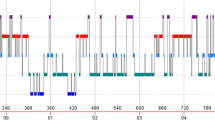Abstract
To test the hypothesis that sleep produced by thalidomide, unlike that of pentobarbital, is associated with increased neuronal activity in the preoptic area (POA), the spontaneous activity of 96 POA neurons was recorded in chronically prepared cats during alert wakefulness (W), deep slow-wave sleep (SWS), and REM sleep in a drug-free preparation and after administration of thalidomide (4mg/kg) and pentobarbital (4 or 8 mg/kg). Thalidomide, unlike pentobarbital, at a dose that significantly increased the amount of SWS, failed to depress neuronal activity in the POA compared to drug-free controls. Mean discharge rates during thalidomide treatment were similar to drug-free rates. In contrast, rates during low-dose pentobarbital treatment were significantly less than those of drug-free and thalidomide-treated animals. Rates during high-dose pentobarbital treatment were significantly less than those in all other groups. Thalidomide, compared with the other groups, in addition to increasing the amount of SWS, significantly increased the total amount of REM sleep as well as REM sleep as a percent of total sleep, but did not produce ataxia or behavioral excitement. These results do not confirm the initial hypothesis, but suggest that hypnotic drugs that do not depress neuronal activity in the POA may be devoid of some of the unwanted side effects often associated with the more commonly prescribed hypnotic medications.
Similar content being viewed by others
References
Bremer F (1977) Cerebral hypnogenic centers. Ann Neurol 2:1–6
Burley D, Dennison TC, Harrison W (1559) Clinical experience with a new sedative drug. Practioner 183:57
Edwards AL (1954) Statistical methods for the behavioral sciences. Holt, Rinehart and Winston, New York
Frederickson RCA, Slater JH, Dusenberry WE, Hews CR, Jones GT, Moore RA (1977) A comparison of thalidomide and pentobarbital. New methods for identifying novel hypnotic drugs. J Pharmacol Exp Ther 203:240–251
Kaitin K (1984) Preoptic area unit activity during sleep and wakefulness in the cat. Exp Neurol 83:347–357
Kales A, Allen C, Scharf MB, Kales JD (1970) Hypnotic drugs and their effectiveness: All-night EEG studies of insomniac subjects. Arch Gen Psychiatry 23:226–232
Killam EK (1962) Drug action of the brain-stem reticular formation. Pharmacol Rev 14:175–224
Kuhn WL, Van Maanen EF (1961) Central nervous system effects of thalidomide. J Pharmacol Exp. Ther 134:60–68
Lasagna L (1960) Thalidomide: A new nonbarbiturate sleep-inducing drug. J Chronic Dis 11:627–631
Lenz W (1966) Malformations caused by drugs in pregnancy. Am J Dis Child 112:99–106
McBride WG (1963) The teratogenic action of drugs. Med J Aust 2:689–693
Mellin CW, Katzenstein M (1962) The saga of thalidomide. N Engl J Med 267:1184–1193, 1238–1243
Olds ME, Olds J (1969) Effects of anxiety-relieving drugs on unit discharges in hippocampus, reticular midbrain, and preoptic area in the freely moving rat. Int J Neuropharmacol 8:87–103
Snider RS, Niemer WT (1961) A stereotaxic atlas of the cat brain. University of Chicago Press, Chicago
Somers GF (1960) Pharmacological properties of thalidomide (α-phthalidoglutarimide), a new sedative hypnotic drug. Br J Pharmacol 15:111–116
Ursin R (1968) The two stages of slow-wave sleep in the cat and their relation to REM sleep. Brain Res 11:347–356
Author information
Authors and Affiliations
Rights and permissions
About this article
Cite this article
Kaitin, K.I. Effects of thalidomide and pentobarbital on neuronal activity in the preoptic area during sleep and wakefulness in the cat. Psychopharmacology 85, 47–50 (1985). https://doi.org/10.1007/BF00427320
Received:
Accepted:
Issue Date:
DOI: https://doi.org/10.1007/BF00427320




